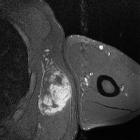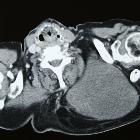myxoid liposarcoma













Myxoid liposarcoma is the second most common subtype of liposarcoma.
Epidemiology
It is the second most prevalent type of liposarcoma, representing 30-40% of all liposarcomas in the extremities.
Pathology
As with all liposarcomas, it is a malignant tumor of adipose tissue. Myxoid liposarcomas arise from the intermuscular fascial planes or deep-seated areas.
They occur most commonly in the lower extremity, particularly the thigh.
Other sites (in decreasing order of frequency) include:
- buttocks
- retroperitoneum
- trunk
- ankle
- proximal limb girdle
- head and neck
- wrist
Genetics
Share a characteristic t(12;16)(q13;p11) chromosomal translocation with round cell liposarcomas, resulting in the formation of the TLS/CHOP fusion oncogene.
Radiographic features
MRI
A spectrum of MR imaging abnormalities can occur depending on the amount of fat and myxoid material, the degree of cellularity and vascularity, and presence of necrosis. Most tend to have lacy or linear, amorphous foci of fat. Some appear cystic on non-contrast sequences.
- T1
- can be variable
- most exhibit high signal-intensity foci within a predominantly homogeneous low signal intensity mass
- T2: lacy areas appear more prominent
- T1 C+
- show enhancement (which can be heterogeneous)
- enhancing areas within the tumor represent increased cellularity and vascularity while non-enhancing areas represent necrosis, reduced cellularity, and accumulated mucinous material
Siehe auch:
und weiter:

 Assoziationen und Differentialdiagnosen zu myxoid liposarcoma:
Assoziationen und Differentialdiagnosen zu myxoid liposarcoma:
